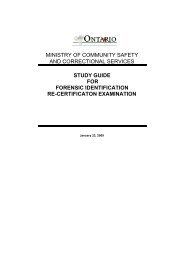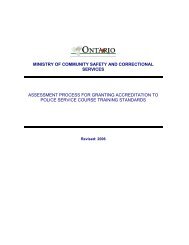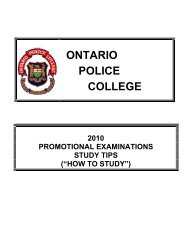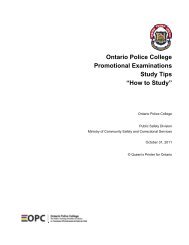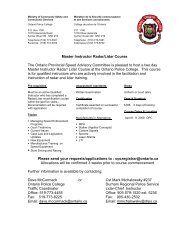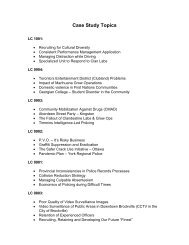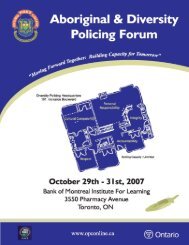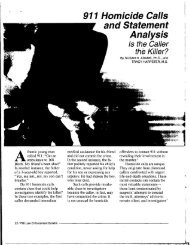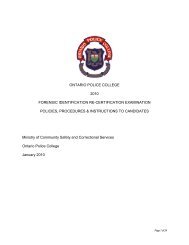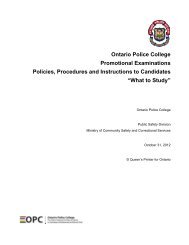General Study Guide - Ontario Police College
General Study Guide - Ontario Police College
General Study Guide - Ontario Police College
Create successful ePaper yourself
Turn your PDF publications into a flip-book with our unique Google optimized e-Paper software.
Wet, Non-Porous & Porous Surfaces – Types and details of chemical processes in proper development sequence – depending on circumstances not<br />
all processes may apply. All processes, however, are post visual and examination of inherent fluorescence by laser or alternate light source.<br />
Development Techniques and ‘Basics’ of Processing Procedure<br />
1. Small Particle Reagent (S.P.R.) (a.k.a. Powder Suspension)<br />
A reagent for latent print processing of non-porous items that<br />
became wet after the impressions were deposited. Suggested for<br />
use on items where latent print powders are ineffective. Not<br />
suggested for items contaminated with greasy substances.<br />
Can be used post-cyanoacrylate when dye stains are ineffective.<br />
The active ingredient (Molybdenum disulfide) is applied either by<br />
spraying or dipping.<br />
Rinse with tap water & dry at room temperature. Prints are more<br />
visible when they are dry.<br />
Photograph any developed detail and then you may try lifting the<br />
dried print.<br />
Latent Print<br />
Development<br />
Colour<br />
Dark grey<br />
Ridge Detail Visualized By<br />
The SPR technique relies on the adherence of fine<br />
particles suspended in a treating solution to the fatty or<br />
oily constituents of latent fingerprint residue.<br />
(Formulated mid 1980s) Accordingly, it may be regarded<br />
as belonging to the same family of methods as powder<br />
dusting. SPR consists of a suspension of fine<br />
molybdenum disulfide particles in detergent solution.<br />
2. Silver Physical Developer (Ag-PD)<br />
First formulated in 1975 by the British Home Office <strong>Police</strong> S.D.<br />
Branch.<br />
PD is a surfactant-stabilized solution containing silver ions, a<br />
ferrous/ferric redox system, a buffer (citric acid) and detergents<br />
in an aqueous solution.<br />
PD is used for the development of lipid type (oily,greasy)<br />
impressions on porous surfaces. (OPC)<br />
PD works well on clay fire bricks, concrete, latex or rubber gloves,<br />
both sides of adhesive tape, rayon or nylon clothing, unfinished<br />
porcelain, unfinished wood and wooden knife handles.<br />
(A.F.T.pg.136)<br />
Dark Grey<br />
It’s water-based and thus it visualizes the waterinsoluable<br />
portion of the latent print residue. These<br />
components include fats and oils (lipids) but also waterresistant<br />
proteins, lipoproteins, and even water-soluable<br />
components (amino acids, proteins, urea, salts etc.) that<br />
get trapped in the lipids as they “dry” and harden<br />
through oxidation.



